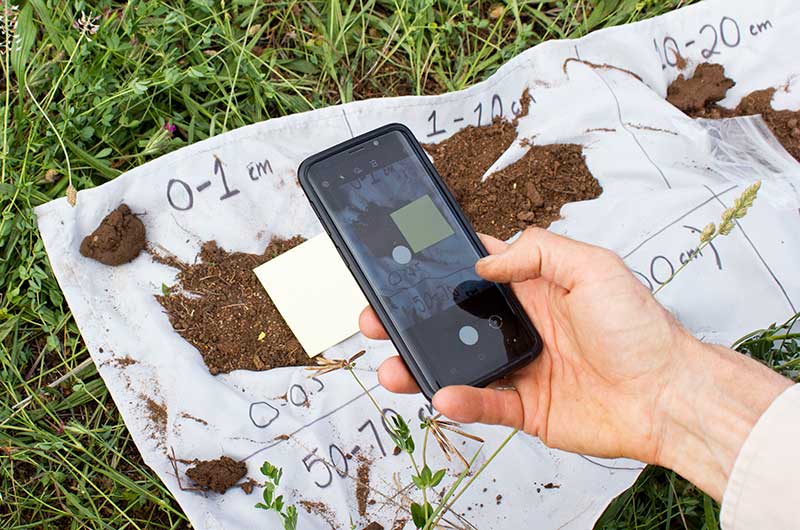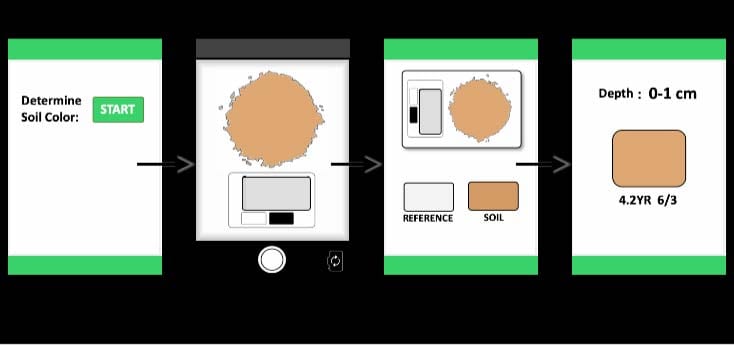LandPKS Learning
Knowledge Hub

Intro to Soil Color
Soil is a critical factor for land potential, productivity, and crop yields. Soil color can be a useful tool for correctly identifying your soil and can be an important indicator of soil health.
Why is soil color important?
Soil is a critical factor for land potential, productivity, and crop yields. Correctly identifying soil is vital information for decision-making for farmers, natural resource managers, land planners, and other land manager. Soil color can be a useful tool for correctly identifying your soil and can be an important indicator of soil health. Soil color is linked to mineral composition, soil fertility, soil organic matter, and more.
How is soil color measured?
The Munsell System is the most commonly used color notation system for classifying soil color. This system allows you to compare soils from any location in the world. The color system has three components:
- Hue: the color (red, yellow, and blue)
- Value: the lightness or darkness of that color
- Chroma: the intensity of the color
For example, a 7.5YR 6/8 is a reddish-yellow soil where 7.5YR represents the hue, 6 is the value, and 8 is the intensity.
To determine your soil color with Munsell, color books are typically used where the soil is compared against the color chips in the book. With the LandPKS app, you can use the camera on your smartphone to take a picture of your soil and determine its Munsell color value.
How do I determine the color of my soil with LandPKS?
LandPKS uses the camera on your smartphone to determine combined with a color reference to determine your soil color. You can access the soil color function from the Data Input screen under LandInfo.

What Reference Card Should I Use?
In the LandPKS app, you can select from several options for reference card in Application Settings. You can choose between:
- WhiBal card
- Camera Trax
- 3M Yellow Post-It*
- User-defined color reference based on an RGB, LAB or Munsell color
*If you are using a 3M Yellow Post-It, we recommend following these guidelines:
- Only use new Post-its
- Stack at least 3 Post-its on top of each other
- Make sure the Post-it notes lays flat, are not written on, and are not dirty
- Make sure the Post-its are not degraded by sunlight as considerable variation can exist
depending on sun exposure - Store Post-it notes in dark envelopes to avoid sun exposure
Tips for a more accurate soil color estimate
- Take your picture in the bright even sunlight. Clouds and shadows will impact the accuracy of your soil color estimate.
- Before taking the picture of your soil and your reference, sieve soil through a 2mm sieve to create a pile of homogenous soil. Flatten the pile of soil to minimize shadows within the soil sample.
- Use dry soil whenever possible. The app does have a way to indicate if your soil is wet, but dry soil color estimates are more accurate.
- If your soil layer has multiple colors (i.e. mottles, redoximorphic features, or carbonates), isolate the dominate matrix color from the pile.
Download
Download Intro to Soil Color as a PDF
Further Reading
- Measurement of Soil Color: A Comparison Between Smartphone Camera and Munsell Color Book (PDF, 3 MB)
- Soil Color: A Smartphone-Based Application to Estimate Soil Color, presentation by Shawn Salley (PowerPoint, 23 MB)
- The Color of Soil – USDA NRCS
Mobile App | Data Portal | Knowledge Hub | Habitat Hub | Learning Collections | Blog | About | Contact | Support



